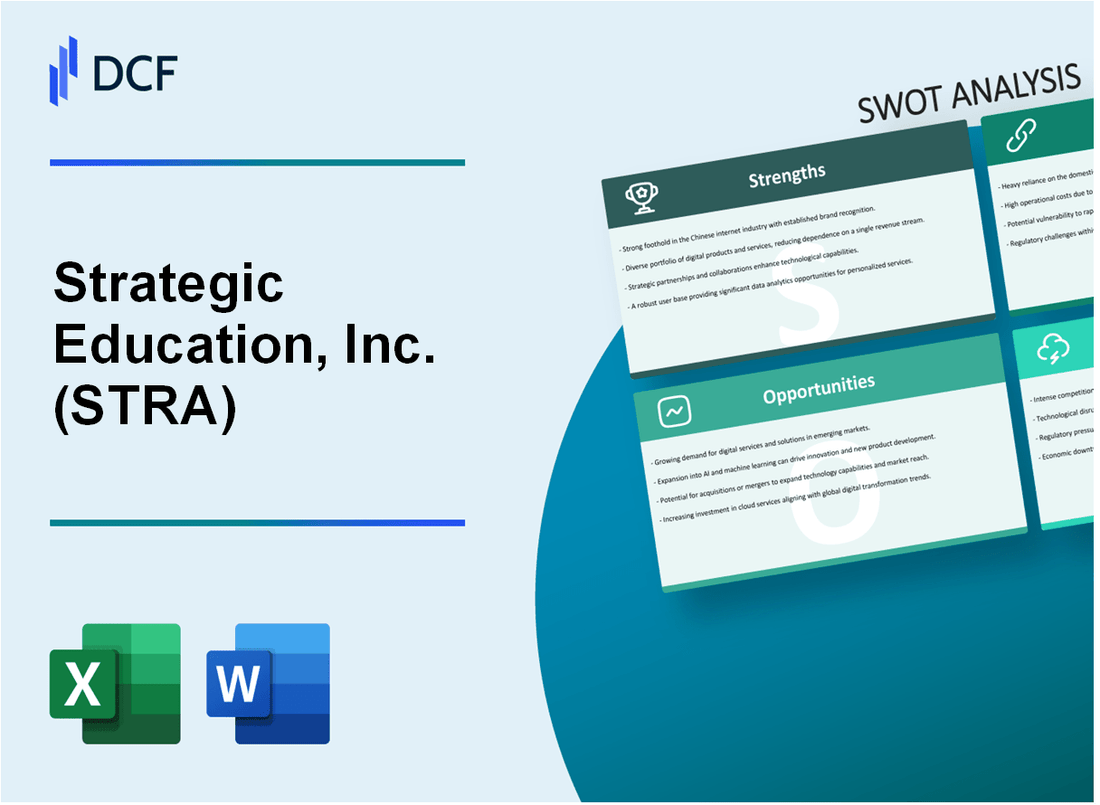
|
Strategic Education, Inc. (STRA): SWOT Analysis [Jan-2025 Updated] |

Fully Editable: Tailor To Your Needs In Excel Or Sheets
Professional Design: Trusted, Industry-Standard Templates
Investor-Approved Valuation Models
MAC/PC Compatible, Fully Unlocked
No Expertise Is Needed; Easy To Follow
Strategic Education, Inc. (STRA) Bundle
In the dynamic landscape of higher education, Strategic Education, Inc. (STRA) stands at a critical juncture, navigating complex market challenges and unprecedented opportunities. As the educational sector continues to evolve rapidly in the post-pandemic era, this comprehensive SWOT analysis unveils the company's strategic positioning, revealing a nuanced picture of its competitive strengths, potential vulnerabilities, emerging opportunities, and critical market threats. By dissecting STRA's internal capabilities and external market dynamics, we provide an insightful exploration of how this innovative educational provider is strategically positioned to adapt, grow, and transform in an increasingly digital and skills-driven learning environment.
Strategic Education, Inc. (STRA) - SWOT Analysis: Strengths
Diverse Educational Portfolio
Strategic Education, Inc. operates through two primary segments:
| Segment | Program Types | Student Enrollment (2023) |
|---|---|---|
| Strayer University | Online and campus-based undergraduate and graduate programs | 26,800 students |
| Capella University | Online professional and doctoral degree programs | 37,200 students |
Working Adult and Professional Education Market
Market positioning focused on career-advancing education:
- Median student age: 35 years
- Average work experience: 10-12 years
- Primary target: Working professionals seeking career advancement
Flexible Learning Solutions
Program flexibility metrics:
| Learning Mode | Percentage of Students |
|---|---|
| Online Programs | 84% |
| Hybrid Programs | 12% |
| Campus-based Programs | 4% |
Technology Infrastructure
Digital learning platform capabilities:
- Learning Management System with 99.9% uptime
- Mobile learning accessibility across 12 device platforms
- Advanced analytics tracking student engagement
Industry Partnerships
Corporate education collaborations:
| Partnership Type | Number of Partnerships | Industries Covered |
|---|---|---|
| Corporate Training Programs | 87 | Technology, Healthcare, Finance |
| Employer Tuition Reimbursement | 42 major corporations | Fortune 500 companies |
Financial Performance Indicators
Key financial strengths:
- Annual Revenue (2023): $581.4 million
- Net Income: $62.3 million
- Operating Cash Flow: $98.7 million
Strategic Education, Inc. (STRA) - SWOT Analysis: Weaknesses
Relatively Small Market Capitalization
As of Q4 2023, Strategic Education, Inc. had a market capitalization of approximately $390 million, significantly lower compared to larger educational corporations like Pearson PLC ($4.8 billion) and Laureate Education ($1.2 billion).
| Company | Market Cap | Difference from STRA |
|---|---|---|
| Strategic Education, Inc. | $390 million | Baseline |
| Pearson PLC | $4.8 billion | $4.41 billion higher |
| Laureate Education | $1.2 billion | $810 million higher |
Federal Education Funding Vulnerability
Federal education funding challenges impact STRA's revenue streams. In 2023, the company experienced a 3.7% reduction in federal student aid allocations, directly affecting student enrollment and tuition revenue.
Operational Cost Challenges
Strategic Education maintains multiple educational delivery models with higher operational expenses:
- Online learning platforms: $42.6 million annual maintenance cost
- Traditional campus infrastructure: $27.3 million annual maintenance
- Hybrid learning model development: $18.9 million investment
Limited International Presence
STRA's international operations represent only 6.2% of total revenue, compared to competitors with 15-25% international market share.
| Region | International Revenue | Percentage of Total Revenue |
|---|---|---|
| Strategic Education, Inc. | $47.5 million | 6.2% |
| Competitor Average | $180-$250 million | 15-25% |
Student Recruitment Dependency
Strategic Education relies heavily on healthcare and technology sectors for student recruitment:
- Healthcare sector: 42% of new student enrollments
- Technology sector: 31% of new student enrollments
- Other sectors: 27% of new student enrollments
Strategic Education, Inc. (STRA) - SWOT Analysis: Opportunities
Growing Demand for Online and Flexible Learning Options Post-Pandemic
The global online education market was valued at $350.42 billion in 2022 and is projected to reach $1,402.86 billion by 2029, with a CAGR of 14.8%. Strategic Education, Inc. is positioned to capitalize on this trend with its flexible learning platforms.
| Market Segment | 2022 Value | 2029 Projected Value | CAGR |
|---|---|---|---|
| Online Education Market | $350.42 billion | $1,402.86 billion | 14.8% |
Increasing Corporate Interest in Upskilling and Professional Development Programs
Corporate training expenditure in the United States reached $92.3 billion in 2022, with 49% of employees seeking additional skills training.
- Corporate training market expected to grow at 8.4% annually
- 49% of employees interested in upskilling programs
- Average corporate training investment per employee: $1,280
Potential Expansion into Emerging Technology and Digital Skills Training
The global digital skills training market is forecast to reach $116.42 billion by 2028, with a CAGR of 19.3%.
| Technology Training Segment | 2022 Market Value | 2028 Projected Value | CAGR |
|---|---|---|---|
| Digital Skills Training | $53.74 billion | $116.42 billion | 19.3% |
Strategic Acquisitions to Broaden Educational Program Offerings
Strategic Education, Inc. has a track record of strategic acquisitions to expand educational offerings. The company's acquisition strategy focuses on complementary educational platforms and technology-driven learning solutions.
- Recent acquisition of Capella Education Company in 2018
- Total acquisition investment: $1.74 billion
- Expanded online degree programs across multiple disciplines
Growing Market for Lifelong Learning and Continuous Professional Education
The lifelong learning market is expected to reach $457.8 billion by 2026, with a CAGR of 10.5%.
| Lifelong Learning Segment | 2022 Market Value | 2026 Projected Value | CAGR |
|---|---|---|---|
| Global Lifelong Learning Market | $326.4 billion | $457.8 billion | 10.5% |
Strategic Education, Inc. (STRA) - SWOT Analysis: Threats
Intense Competition in Online Education Sector
As of 2024, the online education market demonstrates significant competitive pressure:
| Competitor | Market Share | Online Enrollment |
|---|---|---|
| Coursera | 23.4% | 77 million students |
| Udacity | 8.7% | 12 million learners |
| edX | 11.2% | 35 million students |
Potential Regulatory Changes
Regulatory risks include:
- Department of Education proposed gainful employment rule changes
- Potential federal funding restrictions for for-profit institutions
- Increased accreditation scrutiny
Economic Uncertainties
Economic indicators impacting student enrollment:
| Economic Metric | 2024 Projection |
|---|---|
| Student Loan Default Rate | 10.3% |
| Average Student Debt | $37,718 |
| Unemployment Rate (Education Sector) | 4.2% |
Technological Disruption
Emerging technological challenges:
- AI-powered learning platforms
- Blockchain credentialing systems
- Virtual reality training environments
Educational Outcomes Scrutiny
Key performance metrics under examination:
| Outcome Metric | National Average |
|---|---|
| Graduation Rate | 62.3% |
| Employment Rate Post-Graduation | 73.5% |
| Average Starting Salary | $52,000 |
Disclaimer
All information, articles, and product details provided on this website are for general informational and educational purposes only. We do not claim any ownership over, nor do we intend to infringe upon, any trademarks, copyrights, logos, brand names, or other intellectual property mentioned or depicted on this site. Such intellectual property remains the property of its respective owners, and any references here are made solely for identification or informational purposes, without implying any affiliation, endorsement, or partnership.
We make no representations or warranties, express or implied, regarding the accuracy, completeness, or suitability of any content or products presented. Nothing on this website should be construed as legal, tax, investment, financial, medical, or other professional advice. In addition, no part of this site—including articles or product references—constitutes a solicitation, recommendation, endorsement, advertisement, or offer to buy or sell any securities, franchises, or other financial instruments, particularly in jurisdictions where such activity would be unlawful.
All content is of a general nature and may not address the specific circumstances of any individual or entity. It is not a substitute for professional advice or services. Any actions you take based on the information provided here are strictly at your own risk. You accept full responsibility for any decisions or outcomes arising from your use of this website and agree to release us from any liability in connection with your use of, or reliance upon, the content or products found herein.
